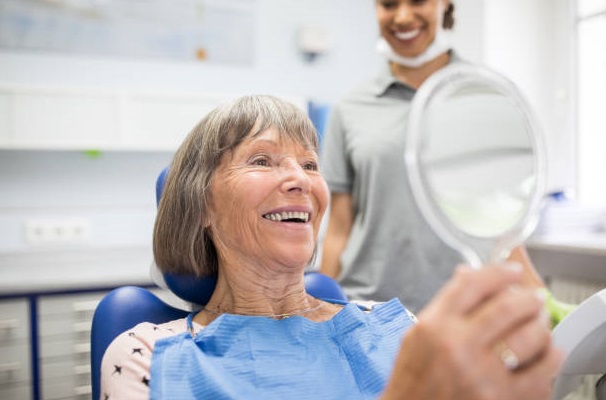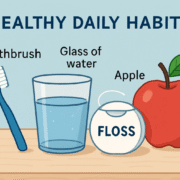Key Takeaways
- Understand the factors that cause tooth discoloration as we age.
- Explore safe and effective teeth whitening methods suitable for seniors.
- Research in-office treatments and natural home cures.
- Find out how important dental health is to a brilliant smile.
- Get insights from authoritative resources on aging and dental care.
Aging and Tooth Discoloration
Maintaining a radiant smile becomes increasingly challenging as one age, yet it is by no means an unattainable goal. Interestingly, teeth whitening remains a topic of great interest among seniors yearning for a dazzling smile without the potential downsides of compromising oral health. As time passes, a blend of lifestyle choices and the natural aging process contributes to teeth losing their brilliance. However, gaining an understanding of these transformations empowers seniors to make informed decisions and select effective whitening strategies without jeopardizing dental well-being.
With increasing age, various factors, such as dietary habits, medications, and the physiological aging process, contribute to the discoloration and dulling of teeth. By gaining insight into how these factors influence dental health, seniors are equipped to opt for approaches that can enhance their smiles and preserve dental vitality in tandem. This knowledge boosts confidence and encourages proactive measures for a brighter outlook on oral aesthetics and functionality.
Common Causes of Tooth Discoloration in Seniors
Many factors help to explain teeth’s darkening over the years. Among the most noticeable is the enamel’s natural weakening which exposes a yellowish layer called dentin beneath. As enamel breaks down with age, this is not unusual. Moreover, frequent intake of stain-inducing agents including tobacco, red wine, coffee, and tea aggravates tooth discoloration. Seniors might not know that some drugs, particularly those meant to control allergies and high blood pressure, could potentially cause changes in tooth color over long use.
Another factor, often overlooked, is the reduction in saliva production, which commonly affects older adults. By washing away food particles and germs, saliva is an important part of keeping the mouth clean. With reduced saliva flow, there is a heightened risk of plaque buildup, leading to more prominent discoloration. Understanding and addressing these contributors can significantly aid seniors in managing discoloration effectively. In most cases, they rely on cosmetic dentistry for efficient solutions.
Safe Teeth Whitening Methods for Older Adults
Navigating through the myriad of whitening options can be overwhelming, especially for seniors. Safety becomes a top priority when selecting methods due to age-related dental changes. Professional whitening treatments performed by dentists, such as laser whitening or custom-fitted trays, offer both control and precision. These methods ensure noticeable results without introducing unnecessary sensitivity that may occur with less supervised alternatives.
For seniors preferring the convenience of at-home solutions, dentist-approved whitening strips or gels may be a favorable compromise. Though typically milder compared to professional treatments, these over-the-counter solutions can still yield significant improvements in tooth color when used consistently and correctly. It’s crucial to implement methods that cater specifically to the needs and sensitivities of older adults, ensuring comfort and effectiveness are not sacrificed.
Natural Remedies and Diet Changes
Fascinatingly, nature provides mild, usually cheap remedies for preserving teeth brightness. Including crisp fruits and vegetables like apples and carrots into the diet not only improves general health but also serves as a natural toothbrush, thereby helping to clear surface stains. These foods boost saliva generation, facilitating oral natural cleaning mechanisms. Also, a good way to gently remove stains and polish teeth is using a paste created from water and baking soda. Because of its moderate abrasive qualities, this is a well-known home cure that is reasonably priced to go along with frequent brushing. These natural solutions provide an easy, chemical-free method to keep and improve tooth brightness.
In-Office Teeth Whitening Solutions
For those who seek expedient and marked results, considering in-office whitening treatments might be ideal. Such procedures are professionally administered using stronger bleaching agents than typically found in at-home kits. Conducted under controlled conditions, these sessions ensure high safety levels, particularly important for older adults with receding gums or sensitive teeth.
Procedures such as laser-assisted whitening are especially effective at addressing deep-set stains within a concise period, making them a popular option for those desiring substantial aesthetic enhancements. Professional consultation with a trusted dentist can help determine which in-office treatment aligns best with individual oral health profiles and desired whitening goals, ensuring a tailored approach that maximizes results while safeguarding dental health.
Maintaining Oral Health for a Bright Smile
Oral hygiene remains a fundamental aspect of dental aesthetics and overall health. Regular brushing with fluoride toothpaste, flossing, and periodic dental visits contribute significantly to preventing discoloration while promoting a healthy oral environment. Such practices build a strong foundation for achieving and sustaining a white smile, especially in older adults.
Moreover, staying hydrated by drinking ample water, particularly after consuming foods or drinks that cause stains, helps maintain brightness. Sufficient hydration ensures saliva production remains optimal, facilitating the neutralization of acids and preventing the buildup of plaque both critical factors in preserving a gleaming smile.
Choosing the Right Whitening Products
Amidst an array of teeth whitening products on the market, prioritizing informed choices is essential. Seniors should focus on selecting products formulated for sensitive teeth and gums to mitigate potential adverse effects. Consulting a dental professional before embarking on any at-home whitening routine can offer guidance and peace of mind.
There are products specially designed for older adults, offering gentle formulations that address sensitivity issues while maintaining a high whitening capability. Evaluating product labels and ingredients carefully ensures the best fit for one’s dental condition and desired outcomes, fostering a safe yet efficient whitening process.
Additional Resources for Senior Dental Care
In pursuit of lifelong dental health, resources such as the Mayo Clinic and similar dental care organizations provide invaluable knowledge and expert guidance. These platforms can prove instrumental for those seeking age-specific dental care tips and innovative whitening strategies to keep their teeth healthy and vibrant.
By leveraging credible expert knowledge and adopting cutting-edge care techniques, seniors can achieve a brighter smile and prolonged dental health, supporting aesthetics and functional longevity crucial for the quality of life in later years.
If you want morе еxciting contеnt visit. Globallyviz.com














Comments